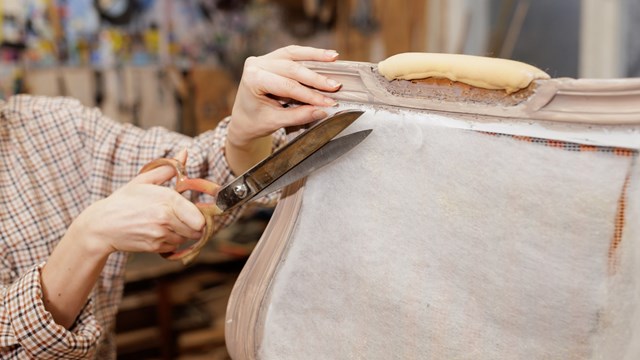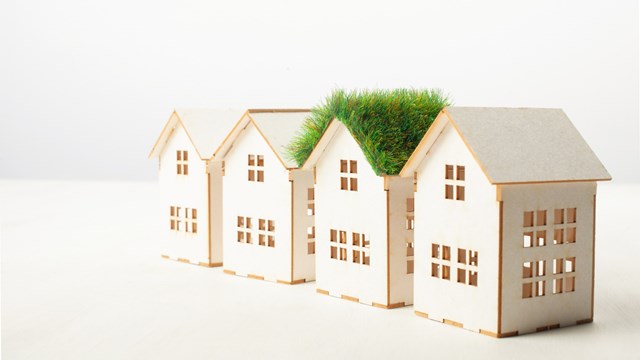
One universal truth on which we all can agree is that kids like to play. They love little more than getting together and having a bang-up good time. And in almost any cooperative, condominium or homeowners’ association, there is likely to be a gaggle of youths who need to burn off some energy. A board is left with the choice between letting this roving band of rapscallions traverse the property unchecked, wreaking havoc on carefully-manicured lawns, or providing a designated place for kids to gather and enjoy some fresh air. Should said board wisely adopt the latter strategy, there’s a name for this type of consolidated entertainment structure, what we call: a playground.
Clearly, the imperative when housing a playground on a condo or co-op premises is safety. There may also ensue shifting community dynamics or potential lawsuits should a child get hurt. Thus every precaution must be taken to prevent that from happening. So what’s new in playground safety? What materials are being adapted into the works? Are kids playing differently than they were, say, a decade ago?
The Legal Brief
Unlike smaller cities with vast suburban enclaves wherein kids can frolic among the trees and the greenery, New York City is famous for being The Big Apple, a town that celebrates fruit trees in name only, as it actually features a ton of giant buildings. Outdoor space amid condominium or co-op communities is at a premium, and boards often have to get inventive in order to carve out a place in which children can recreate. The laws governing play spaces have to be accordingly tight in order to ensure that everyone conducts themselves in a safe fashion, and boards are advised to consult with trained professionals before entering into any binding contract with a playground manufacturer, lest they overlook an important safety code.
Murray Hill’s Waterside Plaza is one facility that has a state-of-the-art outdoor playground. However, buildings like Emerald Green, 320 West 38th Street; the Regent at 45 West 60th Street; Ariel West at 245 West 99th Street; the Brompton at 205 East 85th Street; One Brooklyn Bridge Park at 360 Furman Street; and the Dillon at 425 West 53rd Street, are but some of the developments that offer plush indoor children’s playrooms, which in Manhattan seems to be more the norm.
One of the seemingly most insane things that anyone does—and they actually do this—is put playgrounds on the roofs of buildings. But, when space is, again, at a premium, a board does what it can. "If you're placing a playground on a building roof, you have issues regarding ingress and egress, as well as fencing, that you must address," explains Jack Lepper, a partner with the law firm of Kagan Lubic Lepper Finkelstein & Gold, LLC. "There are regulations overseeing fence height, distance between playground and fence, etc. It's in a board's best interest to contact an architectural or engineering consultant to assure that plans are prepared and filed in accordance with the local requirements."
Safety laws have not changed much in the past few years. The bulk of today's regulations stem from commissions formed in the late ‘80s and early ‘90s, including the U.S. Consumer Product Safety Commission which, according to Lepper, offers product guidelines and brought attention to increasing need for improved technology to prevent head injuries; ASTM International, which provides product specs; and the Americans with Disabilities Act, which addresses compliance with handicap-related issues. As far as Lepper knows, the safety regulations which these organizations introduced to public conversation have not altered significantly of late, but they remain ever meaningful.
Should a condo or co-op be attempting to install a playground for the first time, Lepper recommends that it meet with its attorney to ensure that whatever agreement it's entering into with the distributor or the contractor comply with all applicable rules and regulations. He also recommends that an architect or engineer weigh in to confirm that the scope of a project is not larger than merely the installation of the equipment; were it to require more effort, further professional help may be needed. "Too often, a board will simply sign a proposal from a vendor," he says. "And if you don't allow a law firm to review your agreement, you may not get the representations that you need to ensure that you have a compliant playground that addresses the relevant warranty and liability issues."
Wherein liability is concerned, there are many factors that can play into assigning fault should a child get hurt on playground equipment. "If there's a product defect, or if there's negligence involved in the design or manufacture of said equipment, a claim could ensue," notes Lepper. "A board needs to create contractual responsibility and liability with the equipment's installer. And there's a negligence issue as well: did the installer act in an improper way given its expertise? Did it cause any damage, assuming that the equipment was built to specification? And, of course, the owner harbors some responsibility over his or her own property. Was there negligence on his or her part? Did they put up a fence according to code? Could the playground be considered an 'attractive nuisance?' Were there regulations enacted as to how the equipment may or may not be used? All of these things must be considered by a board in connection with a playground."
The Broadsheet
While each state, municipality, city or township have its own minor variances regarding playgrounds and related issues, much of what governs the equipment on which children goof about is regulated on the federal level.
While each state, municipality, city or town may have its own minor variances regarding playgrounds and related issues, much of what governs the equipment on which children play around is regulated on the federal level.
“The Consumer Product Safety Commission has set standards for many years—since 1981,” explains Brandy Smith, project coordinator with the National Program for Playground Safety. “The CPSC produces the Handbook for Public Playground Safety, which was last re-evaluated in 2010. The information in this handbook is compiled by the American Society for Testing & Materials (ASTM), an international group that includes playground manufacturers, among many varied organizations, which meets twice per year, and from that stems the requisite evaluations.”
One of the major recent changes in playground regulation came from the Americans with Disabilities Act in 2012, at which point playgrounds were federally mandated to meet ADA requirements, according to Paul Edwardson, Certified Playground Safety Inspector Instructor for the National Recreation and Park Association.
“Many playground manufacturers have been achieving or exceeding ADA requirements for a while,” notes Karen Snyder, playground safety manager with the NRPA. “There is more recognition now for playgrounds to serve people of all abilities, so you’ll see inclusive equipment that allows able-bodied children to play directly alongside children with disabilities. There are also sensory playgrounds for people who deal with issues like autism. In 2014, Galveston County Parks and Senior Services in Texas put in the country’s first playground for seniors. So playgrounds continue to evolve to meet the needs of diverse audiences, and can be a great way for a community to express itself through play and play structures.”
In recent years, change in playground safety standards has been minimal. “Over the past few years, changes have been data driven, based on injury data or lack thereof,” says Edwardson. “For example, it used to be that, based on the height of a slide, it could be required to have up to 14 feet of clear distance at the end of a slide. Lack of injury data, however, showed that it could be relaxed, and now the minimum clear distance at the end of a slide is six feet, while the maximum requirement is eight feet.”
And Smith notes that one of the biggest changes in playground aesthetics of late is the incorporation of more natural elements. “It’s probably one of the hardest things to work with as far as standards, because a lot of the natural playgrounds contain organic elements. And you can’t put a standard on a rock. There’s a grey area when you’re not dealing specifically with manufactured playground equipment, and that’s one of the bigger challenges about which we get many phone calls right now, as programs move to the more natural motifs.”
The Front Lines
Nobody knows more about what’s hot and hip in the world of condo playground equipment than someone who makes playground equipment for the world of condos. Richard Hagelberg, an early childhood educator and the CEO of Kidstuff Playsystems in Gary, Indiana, has been in the recreational playground game for decades, and has the skinny on what’s new.
“Condos and HOAs are looking to maximize the amount of play value they can get for their money, which is why they’re a good niche market for us, a smaller playground manufacturer, to specialize,” he notes. “There are certain extremely fancy and expensive designs that appeal to the parks and rec market but those are usually outside the price range of the condo/co-op/HOA demographic.”
As far as what’s the rage these days, Hagelberg hasn’t seen the natural trend mentioned by Smith above permeating the condo market just yet. “There’s a company that makes something that looks like a giant tree, so if you have $50,000 to spend on such things, that will appeal to you. We re-sell play rocks that are 7-8 ft. high, 10-15 ft. long. But we don’t see much demand for them. We build a lot of climbing elements into our systems: climbing and sliding, overhead ladder-type elements are all still very popular. We have a big slide with three chutes that kids love. Spiral slides. One of the newer things is net climbers, but they can cost $15,000 plus installation. They’re more popular with parks and schools,” he says.
In regard to safety, Hagelberg strongly urges boards to maintain their surfaces. “A condo environment usually doesn’t want to spend money for a rubber tile surface; it’s more likely to opt for wood chips or loose rubber, both of which are softer than poured-in-place rubber or rubber tiles in terms of preventing broken arms and ankles. There’s nothing wrong with wood chips or loose rubber, it’s just that they’re maintenance-intensive, and the wood chips have to be maintained at a depth of 10-12 inches, and loose rubber needs to be maintained at a depth of six inches. Loose rubber is incredibly soft and nice to land on, but it gets displaced very easily.”
A newer, more modern concern that has emerged of late is simply getting the kids excited to go outside and play in the first place—what with touchscreens and apps running amok and capturing everyone’s time. “There’s been a shift in public attitude,” laments Hagelberg. “Kids are not getting exercise like they used to, with the predominance of computers and iPhones. While we haven’t noticed any hit in sales, I honestly don’t know how many people consider it vital in their environments to have a playground for kids.”
“We have this belief that we have to have some designated place for kids to play, but if you watch how they act naturally, they like to run,” adds Smith. “They like to jump. Sometimes it seems as if adults are pushing upon them this belief that they have to have something flashy. And granted, that flashy thing can help as a selling point for a condo. But a more optimistic mindset for a board would be ‘let’s have a green space that’s fenced in and is safe, in which kids can bring a ball and just play.’ That’s what’s behind the push for natural playgrounds. It’s not that you’re just leaving kids alone to destroy your grass; it’s a thoughtfully-planned approach to adhere to how kids naturally play. Watch your kids and see what they do, and then cater to that. It’s not rocket science. It’s how kids have always played. There’s just a different belief now as to what they actually need.”
Michael Odenthal is a staff writer for The Cooperator and other publications.






Leave a Comment